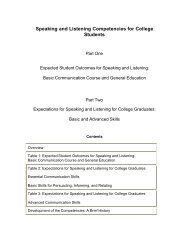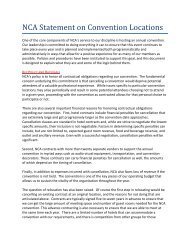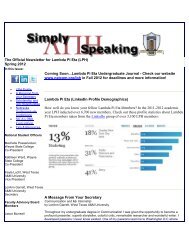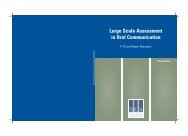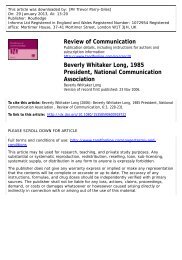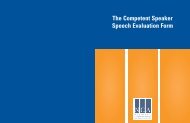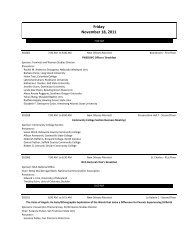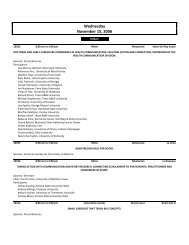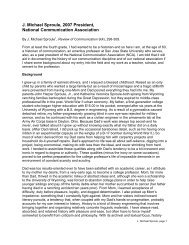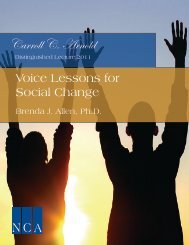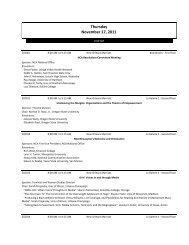Assessing Motivation to Communicate - National Communication ...
Assessing Motivation to Communicate - National Communication ...
Assessing Motivation to Communicate - National Communication ...
- No tags were found...
You also want an ePaper? Increase the reach of your titles
YUMPU automatically turns print PDFs into web optimized ePapers that Google loves.
IV. LOGISTICS AND ADMINISTRATION OF THE INSTRUMENTSUsing Web-based instrumentsElectronic versions of the Personal Report of <strong>Communication</strong>Apprehension (PRCA-24) and the Willingness<strong>to</strong> <strong>Communicate</strong> (WTC) and a software program thatau<strong>to</strong>matically scores each of the instruments are availableon the Internet at http://www.uccs.edu/~webdept/excel/comm_prepost/index.php. To administer the instruments,send respondents <strong>to</strong> take the instrumentsonline <strong>to</strong> this website. Users will type in their e-mailaddress and name and then click “login” (Don’t worryabout the class — only one can be chosen — “<strong>Assessing</strong><strong>Motivation</strong> <strong>to</strong> <strong>Communicate</strong>”). This will take users<strong>to</strong> the page where they can choose <strong>to</strong> take a test (one oftwo). As soon as the respondent completes each instrument,the program scores and presents the results. Theresults may be printed out and retained for data analysispurposes by the test administra<strong>to</strong>r. A link at the bot<strong>to</strong>mallows the user <strong>to</strong> return <strong>to</strong> the “index” (choice oftests page) where they can then take the other test. Thebackend s<strong>to</strong>res the data based on email address andname. Each respondent must use a unique e-mail address.Individual item scores, group scores, and <strong>to</strong>talswill be downloaded <strong>to</strong> an Excel file that will be housedon a server at the University of Colorado at ColoradoSprings (UCCS). Should the test administra<strong>to</strong>r requireindividual items scores, please send an e-mail request<strong>to</strong> Shawn Morgan (smorgan2@uccs.edu), instruc<strong>to</strong>rat UCCS and the system administra<strong>to</strong>r. The requestshould include all of the e-mail addresses from eachrespondent.Providing background <strong>to</strong> students aboutthe instrumentsBefore administering the instruments <strong>to</strong> students, use theinformation in the BACKGROUND and FACT SHEETsections of this program <strong>to</strong> explain what the instrumentsassess and why it is important <strong>to</strong> learn about one’s ownmotivation <strong>to</strong> communicate. Include definitions and descriptionsof: communication competence as motivation,knowledge, and skills; communication apprehension (andpublic speaking anxiety if the students are taking a publicspeaking course); and willingness <strong>to</strong> communicate.Creating a “safe environment” for administrationof the instrumentsWhen administering these two instruments, it iscritical <strong>to</strong> create a safe and supportive environment inwhich the students fill out the instruments and learntheir scores. Given that some students may score high incommunication apprehension or low in willingness <strong>to</strong>communicate, it is necessary that scores be confidentialbetween the administra<strong>to</strong>r and the student. In addition,students should be advised that there is not a right orwrong score; rather, the scores are diagnostic and serve<strong>to</strong> highlight aspects of communication motivation thatmay need some attention and development.V. ANNOTATED BIBLIOGRAPHY OF RESEARCH ARTICLESThe two assessment instruments contained in thisprogram have been used extensively for years by communicationscholars as well as researchers from manyother academic disciplines. The following academic articlesare annotated here in order <strong>to</strong> provide the readerwith some sense of how the instruments have provenuseful <strong>to</strong> others. The articles are categorized chronologicallywithin three categories. Studies that used thePersonal Report of <strong>Communication</strong> Apprehension arepresented first, then those that used the Willingness <strong>to</strong><strong>Communicate</strong>, and then studies that made use of bothinstruments. Some of the annotated articles used the instrumentsin research studies while others focus on thedevelopment and testing of the psychometric propertiesof the instruments. The annotations are immediatelyfollowed by a copy of the <strong>National</strong> <strong>Communication</strong>Association’s official guidelines and criteria for the assessmen<strong>to</strong>f oral communication.Personal Report of <strong>Communication</strong>Apprehension (PRCA)McCroskey, J., Beatty, M., Kearney, P. & Plax, T. (1985).The content validity of the PRCA-24 as a measure ofcommunication apprehension across communicationcontexts. <strong>Communication</strong> Quarterly, 33(3).14 <strong>Assessing</strong> <strong>Motivation</strong> <strong>to</strong> <strong>Communicate</strong>




